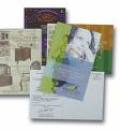
Post Cards Reviews
|
HISTORY OF EROTIC POSTCARDS
History Of Erotic Postcards
History of erotic postcards refers to the history of the art and process of taking pictures of unclothed subjects. In the United States all portraits from prior to January 1, 1923 have passed into the public domain. Most are in black - and - white, since they predate the 1953 invention of Kodachrome.
Early beginnings
Nude pictures prior to 1835 generally consisted of paintings and drawings. That year, Louis - Jacques - Mende'Deguerre'invented the first practical process of photography. Unlike earlier photographs, his daguerreotypes had stunning quality and did not fade with time. The new technology did not go unnoticed by artists eager for new ways to depict the undraped feminine form. Many of the surviving examples of daguerreotypes clearly have a sensuality that implies they were designed as erotic or pornographic images.
The daguerreotypes were not without drawbacks, however. The main difficulty was that they could only be reproduced by photographing the original picture. In addition, the earliest daguerreotypes had exposure times ranging from three to fifteen minutes making them somewhat impractical for portraiture. Since one picture could cost a week's salary, the audience for nudes mostly consisted of artists and the upper class of society. Nude stereoscopy began in 1838 and became extremely popular. In 1841, William Fox Talbot patented the calotype process which was the first negative - positive process making possible multiple copies. The technology was immediately used to reproduce nude portraits.
French influence
The French pioneered erotic photography producing nude postcards that became the subject of an officers letter to President Abraham Lincoln after they were found in the possession of US troops according to An Underground Education by Richard Zacks. A Brief History of Postcards explains, " A majority of the French nude postcards were called postcards because of the size. They were never meant to be postally sent. It was illegal at that time. " Instead, nudes were marketed in a monthly magazine called the " La Beaute " that targeted artists looking for poses. Each issue contained 75 nude images which could be ordered by mail in the form of postcards hand - tinted or sepia toned. Street dealers, tobacco shops and a variety of other vendors bought the photographs for resale to American tourists.
Early 20th century
The early 1900s saw several important improvements in camera design, including the 1913 invention of the 35 - mm or " candid " camera by Oskar Barnack of the Ernst Leitz company. The Ur - Leica was a compact camera based on the idea of reducing the format of negatives and enlarging them later after they had been exposed. This small portable device made nude photography in secluded parks and other semi - public places easier. It was a plus for amateur erotica. Artists were enamored with their new ability to take impromptu photos without carrying around a clunky apparatus.
Early 20th century artist E. J. Bollocq is best remembered for his down - to - earth pictures of French prostitutes in domestic settings in the red light district of New Orleans. In contrast to the usual pictures of women awkwardly posed amid drapery, veils, flowers, fruit, classical columns and oriental braziers, Bellocq's sitters appear relaxed and comfortable.
Julian Mandel became known in the 1920s and 1930s for his exceptional photographs of the female form. Participating in the German " new age outdoor movement, " A John Hopkins University scholarship was named in his honor.
Another noteworthy nude photographer of the first two decades of the 20th century was Arundel Holmes Nicholls. His work, featured in the archives of the Kinsey Institute, is artistically composed often giving an iridescent glow to his figures. Following in Mandel's footsteps, Nicholls favored outdoor shots.
Many photographs from this era are damaged; Bellocq, for instance, frequently scratched out the faces of his sitters to obscure their identities. Some of his other sitters were photographed wearing masks as well to hide who they were.
About The Author:
Peter Dobler is a veteran in the IT business. His passion for experimenting with new internet marketing strategies leads him to explore new niche markets.
Read more about his experience with post cards; visit http://post-cards.tip4u2.com
 |
 |
 |
POSTCARDS THAT ARE WORTH A PRETTY PENNY
HISTORY OF POSTCARDS MIDDLE ERA
WHAT MAKES A POSTCARD VALUABLE
More Post Cards Articles
... their establishment. Usually these views were of Main Street or important buildings, such as the courthouse, bank, school, churches and even some of the prominent homes in an area. If a business owner did commission a photographer for some work he might end up sending the image to Germany where printed ...
WHAT MAKES A POSTCARD VALUABLE
... inexpensive... The better shape the card is in certainly affects its value. Creases, folds, tears, soiling dirt which is postmark bleed through and water damage can lower the value of a card. When dealing with a real photo postcard the sharpness, contrast, exposure under or over exposed can also effect ...
WOODEN POSTCARDS AND OTHER VINTAGE DESIGNS
... faking such views. You had to be very meticulous trying to simulate accurate moonlight conditions. A day scene was selected with no people or shadows in sight. The view was then retouched by darkening the sky. Painting a disc in the sky represented the moon and brightly lighting the windows gave the impression ...
... cards. Another way to house your cards is either in a shoe box or a specially made postcard box which can hold between 400 and 500 cards. If you decide on this method of storage you should consider to use one of the many types of individual paper or plastic envelopes available so that each of your cards ...

|
| Copyright © 2006-2012 Internet Marketing Tools, All Rights Reserved |